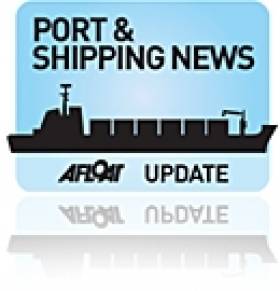Displaying items by tag: Dredging Waterford Estuary
Freeing Up Shipping Channel As Dredger Plies Waterford Estuary
#Dredging - Freeway, a trailing suction hopper dredger is working on removing silt from the shipping channel on Waterford Estuary between Belview Port and out to sea, writes Jehan Ashmore.
The Dutch flagged vessel with a dredging spoil capacity of 4,500m3 began duties last week on what in total will be a continuous 14-day dredging operation. Dumping is taking place at an approved site south-west of Hook Head.
Freeway is a sister of Causeway, which last year carried out the same work for the Port of Waterford. The dredgers form part of a 30 strong fleet from Dutch specialists Boskalis Westminster B.V, whose agent in this country is Irish Dredging Ltd.
The port which has a container (lo-lo) terminal at Belview also handled a 10% increase in tonnage of bulk cargoes in 2015 compared to 2014.
In addition Waterford City welcomed 16 cruise ships in 2015, including those making anchorage off Dunmore East. The cruise sector has provided further economic spin-offs for the city and the wider south-east region.
#DredgingWaterford – Dredging maintenance operations are underway on Waterford Estuary as Causeway is kept busy to ensure shipping lanes are of the required depth, writes Jehan Ashmore.
The Irish Dredging Company Ltd which is an agent for Dutch based global maritime services company Boskalis have deployed the 4,320 tonnes Causeway, a trailing suction dredger hopper on a contract with the Port of Waterford Company. The 2013 built dredger is carrying out a continuous 10-day dredging campaign from Belview seawards.
Causway at 92m long and a capacity for 4,200m3 is one of the largest dredgers to operate in Irish waters. The dredged spoil is been discharged at an approved dumping site south-west off Hook Head.
Dredging works began last week and among the shipping traffic this afternoon at the mouth of Waterford Estuary is P&O Cruises smallest fleet member, Adonia of 30,000 tonnes.
The Bahama-flagged visitor with a 710 passenger capacity is on an anchorage call off Dunmore East.
As previously reported on Afloat.ie, she represented the first P&O Cruises caller to Killybegs with a visit last week.
Adonia's crew of 385 will be preparing the 180m cruiseship as she is set to depart early this evening on a passage to St. Peter Port, Guernsey.
Also anchored off the Irish harbour are a pair of general cargoships. The Elbetor bound for New Ross and Imina which is awaiting orders having sailed downriver from the inland Co. Wexford port.






























































